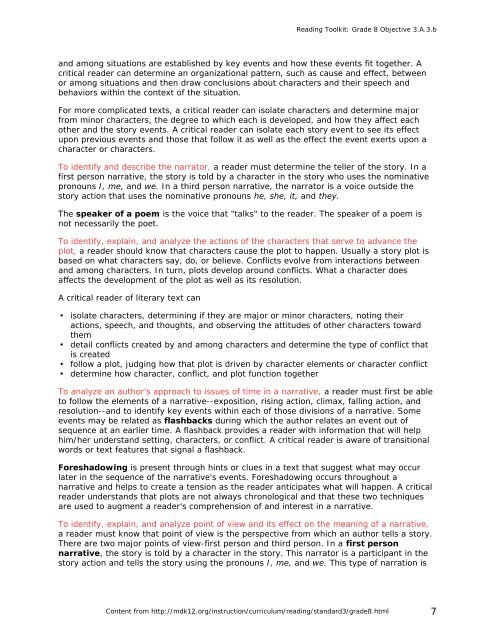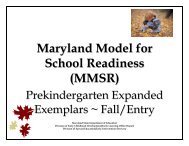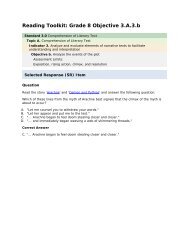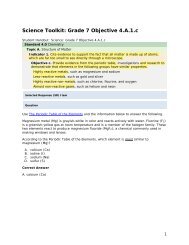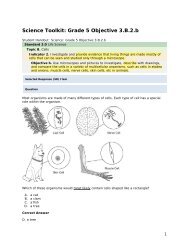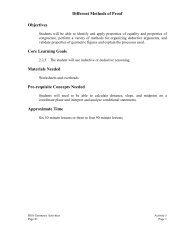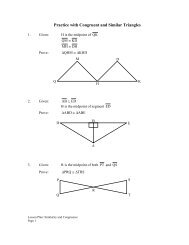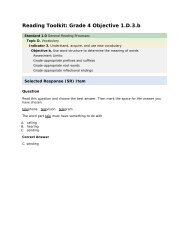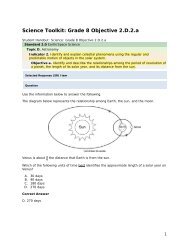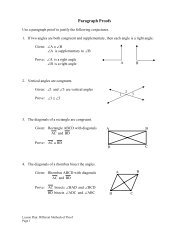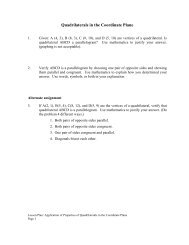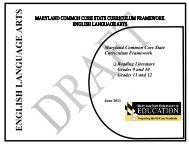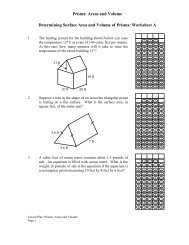Reading grade 8 3.A.3.b - mdk12
Reading grade 8 3.A.3.b - mdk12
Reading grade 8 3.A.3.b - mdk12
Create successful ePaper yourself
Turn your PDF publications into a flip-book with our unique Google optimized e-Paper software.
<strong>Reading</strong> Toolkit: Grade 8 Objective <strong>3.A.3.b</strong><br />
and among situations are established by key events and how these events fit together. A<br />
critical reader can determine an organizational pattern, such as cause and effect, between<br />
or among situations and then draw conclusions about characters and their speech and<br />
behaviors within the context of the situation.<br />
For more complicated texts, a critical reader can isolate characters and determine major<br />
from minor characters, the degree to which each is developed, and how they affect each<br />
other and the story events. A critical reader can isolate each story event to see its effect<br />
upon previous events and those that follow it as well as the effect the event exerts upon a<br />
character or characters.<br />
To identify and describe the narrator, a reader must determine the teller of the story. In a<br />
first person narrative, the story is told by a character in the story who uses the nominative<br />
pronouns I, me, and we. In a third person narrative, the narrator is a voice outside the<br />
story action that uses the nominative pronouns he, she, it, and they.<br />
The speaker of a poem is the voice that "talks" to the reader. The speaker of a poem is<br />
not necessarily the poet.<br />
To identify, explain, and analyze the actions of the characters that serve to advance the<br />
plot, a reader should know that characters cause the plot to happen. Usually a story plot is<br />
based on what characters say, do, or believe. Conflicts evolve from interactions between<br />
and among characters. In turn, plots develop around conflicts. What a character does<br />
affects the development of the plot as well as its resolution.<br />
A critical reader of literary text can<br />
• isolate characters, determining if they are major or minor characters, noting their<br />
actions, speech, and thoughts, and observing the attitudes of other characters toward<br />
them<br />
• detail conflicts created by and among characters and determine the type of conflict that<br />
is created<br />
• follow a plot, judging how that plot is driven by character elements or character conflict<br />
• determine how character, conflict, and plot function together<br />
To analyze an author's approach to issues of time in a narrative, a reader must first be able<br />
to follow the elements of a narrative--exposition, rising action, climax, falling action, and<br />
resolution--and to identify key events within each of those divisions of a narrative. Some<br />
events may be related as flashbacks during which the author relates an event out of<br />
sequence at an earlier time. A flashback provides a reader with information that will help<br />
him/her understand setting, characters, or conflict. A critical reader is aware of transitional<br />
words or text features that signal a flashback.<br />
Foreshadowing is present through hints or clues in a text that suggest what may occur<br />
later in the sequence of the narrative's events. Foreshadowing occurs throughout a<br />
narrative and helps to create a tension as the reader anticipates what will happen. A critical<br />
reader understands that plots are not always chronological and that these two techniques<br />
are used to augment a reader's comprehension of and interest in a narrative.<br />
To identify, explain, and analyze point of view and its effect on the meaning of a narrative,<br />
a reader must know that point of view is the perspective from which an author tells a story.<br />
There are two major points of view-first person and third person. In a first person<br />
narrative, the story is told by a character in the story. This narrator is a participant in the<br />
story action and tells the story using the pronouns I, me, and we. This type of narration is<br />
Content from http://<strong>mdk12</strong>.org/instruction/curriculum/reading/standard3/<strong>grade</strong>8.html 7


